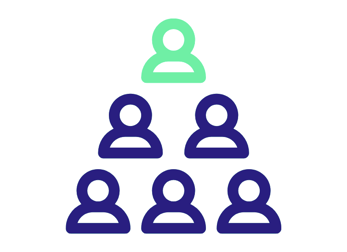Posted on July 29, 2020
Updated on October 23, 2020
3 min read time

Products and services center around people – and brands wouldn’t exist without the people who purchase them. Brands are born when someone notices an unmet or insufficiently met need in the market. That’s why it’s so important to get to grips with who it is you want to buy your product. In short: it’s about knowing your audience.
Deeply understanding your audience and their needs is crucial to making your brand a success. After all, if you don’t know who you’re talking to, how can you expect to make a connection with them? In order to build a successful brand, you need a firm grasp of your target audience. Defining your audience gives you a key piece of the foundation that will become your brand strategy.
Your target audience is the ideal group of consumers that you want to attract to your brand. These are the people that will benefit most from your product; the people who will find it applicable to their lives or look to it to solve a problem. You can define your target audience by asking yourself some of these questions. Take a look:
Demographics describe the traits of your core consumer. Their age, gender, occupation, socioeconomic status, and more can all be a part of their demographic breakdown. Are they young or old? What gender do they identify with? Do they have a full-time job? Do they have a lot of disposable income or are they savings-oriented and looking for purchases based on necessity?
All of these questions combine to give you a clearer image of your customer. For example, if you’re selling an anti-aging skin cream, you’ll want to understand an older age demographic rather than teenagers. Alternatively, if you’re selling something for kids, you’ll want to know what makes them and their parents tick, rather than empty nesters. Depending on the brand you're building, consider how your target audience’s demographics can help shape the positioning of your brand.
This question can be interpreted several different ways and for different reasons. “Location” can be as literal as country, region, state, territory, county, city, or town. Defining your geography has a lot to do with where you plan on getting distributed. Maybe your distribution is limited to a region, or maybe you have the means to reach worldwide. How you segment your target audience down will greatly differ depending on your goals .
Your target audience’s geography can also refer to the kind environment that a consumer lives in. Does your ideal customer live in an urban area or a rural area? Do they live in a house or an apartment? Do they have roommates, significant others, or do they live alone?
Putting your ideal customer in context will help you determine the types of products and product benefits to serve them with. For example, if distribution is limited to a single geographic region, you should tailor language and product attributes to the people that live within that region. So, if you’re selling skincare products and your target audience lives in Alaska, you should make sure that you have products for dry skin. If you’re selling clothing to people in the Caribbean, you can probably leave winter coats out of your product lineup.
Lifestyle can be defined across many different parameters, but let’s limit it to mindset, hobbies, character, and values.
Whereas geographic and demographic segmentations have slightly more rigid boundary lines, lifestyle segmentations are a bit more fluid. They allow you to speak to all types of people, young to old, rural to urban, so long as they have the same mentality.
What is your ideal customer thinking about most of the time? What do they like to do for fun? How would their friends describe them? And what kind of values drive them towards buying specific products?
This question can be difficult to answer, as it tends to be less apparent than the other more straightforward questions. After all, you can’t look at a person’s ID and discover that on weekends they enjoy working with oil paints. Still, having an idea of what your ideal customer is driven by in terms of their core values and character should be possible for you to answer on the most basic level. Are they more traditional or more contemporary? More conservative or more liberal? Do they give to charities, recycle, or concern themselves with the environment? Answering questions in this vein will help you fill out that full picture of your target audience.
At ProQuo AI, we can help you to answer every question you have about your target audience on our brand management platform. Get a solid idea of who you’re selling to with our LIVE Summary Dashboard, which gives you daily feedback on your brand’s performance. Learn which segments feel strongest towards your brand and know how to win them over. Our AI-powered brand guidance tells you exactly what to do to get superior results and to deliver your product into the hands of the people who love it most.
Interested in learning more about how to optimize your brand? Take a look at our guide, “How to Build a Brand Strategy” to learn more.
Our intelligent platform will take your brand further, faster.
Don’t believe us?
Quick links
Get in touch
hello@proquoai.com
368 9th Ave, New York, NY
10001, USA
1100 Ludlow St, Philadelphia, PA
19107, USA
245 Hammersmith Road, London, United Kingdom, W6 8PW
173 Oxford Road Johannesburg 2196,
South Africa
© 2020 ProQuo AI All rights reservedWebsite by Blend